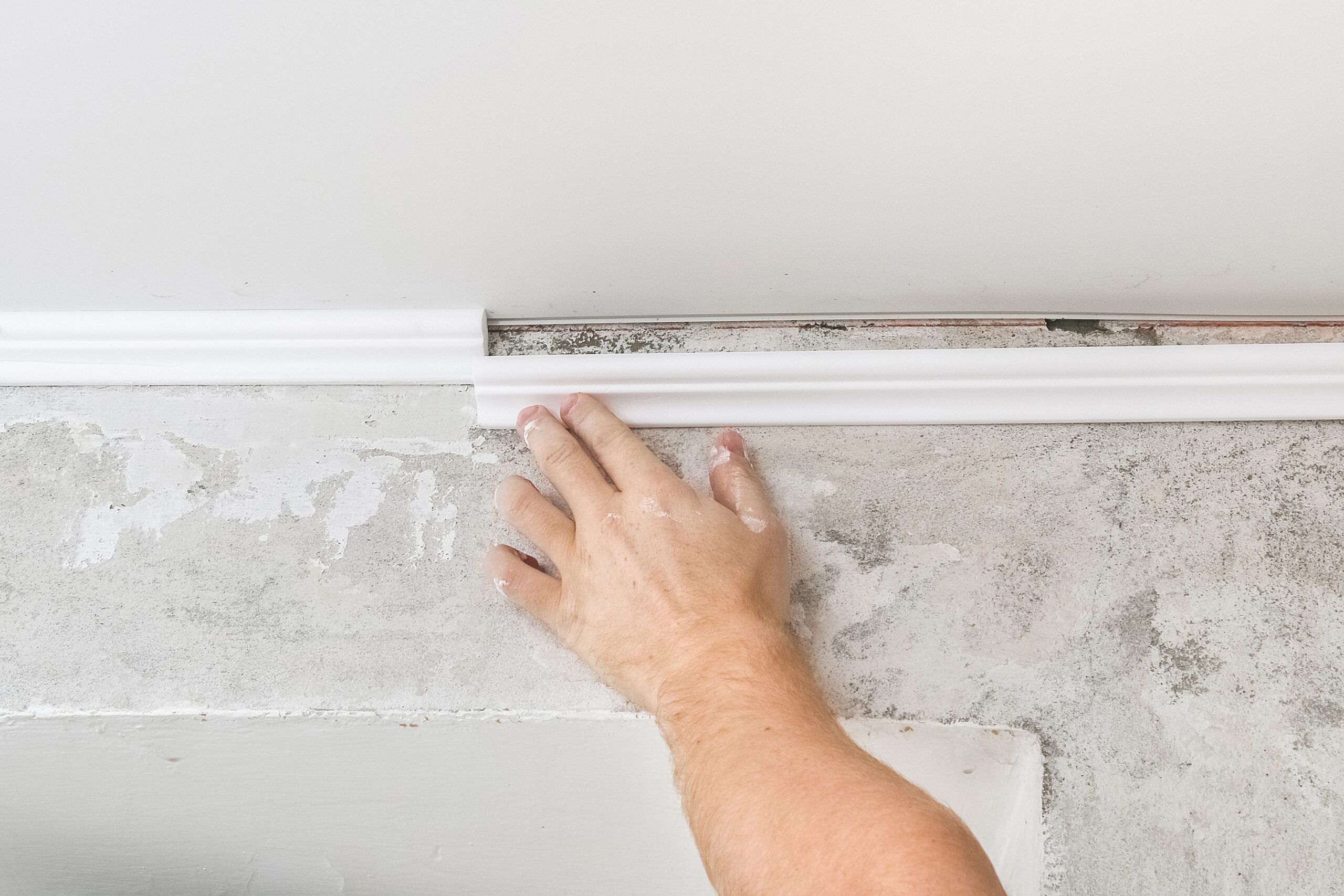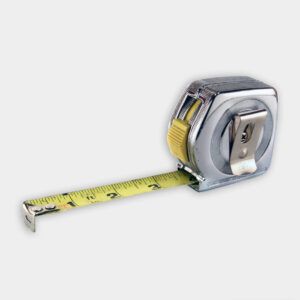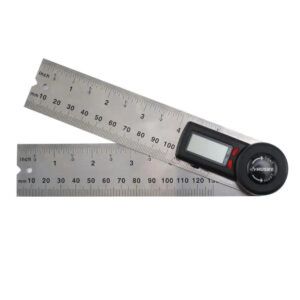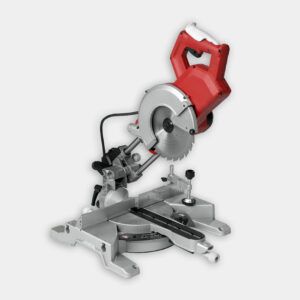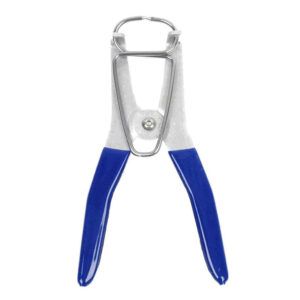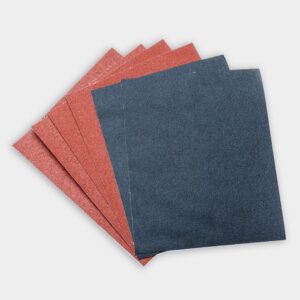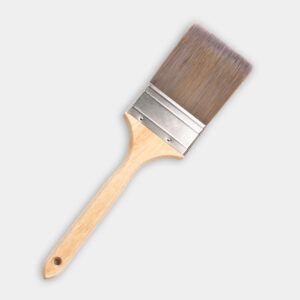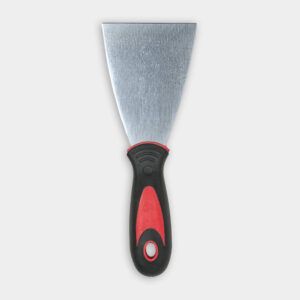Project details
Skill
Cost
Estimated Time
Shoe molding is that thin piece of molding you see in many homes during the transition between baseboard trim or cabinets and the floor. The most common type looks like a simple quarter round, but it can come in other profiles, too, including a rectangle with a curved edge or something with more detail resembling a tiny baseboard molding.
Installing shoe molding is one of the easiest trim projects, requiring only a few tools and some basic carpentry skills. We’ll walk you through the entire process, including choosing materials, making measurements and cuts, and installing the trim in your home.
Where to Install Shoe Molding
The primary use for shoe molding is to cover gaps where flooring meets adjacent vertical surfaces, especially when the flooring was installed after the baseboard trim and cabinetry. Because shoe molding is so thin, it’s very flexible, which allows it to easily conform to any dips or curves where floors may have sagged, or walls are not completely flat. Even if you don’t have any gaps to hide, shoe molding is a nice way to dress up the baseboard trim in your home.
Know the Different Types of Shoe Molding
The first step in planning your project is choosing the molding profile that will look right in your home.
Quarter-Round Molding
The most basic shoe molding looks similar to quarter-round molding, but it’s a little taller and flatter on the side that abuts the baseboard trim. This molding style is clean and simple, easy to find, and looks good in any style room.
Shoe Molding
Most building supply stores also carry a more traditional shoe molding which is thinner and has a flat face with a detailed top edge. This is a bit more formal looking than quarter-round molding, and would be fitting in a room with colonial-style existing trim. If neither of these are the look you’re going for, check with your local lumber yard for other possible options.
What is Shoe Molding Made of?
The next choice you need to make is the material you want your molding to be made of. This decision may be influenced by what existing trim you have in your house, but it’s really up to you.
If your shoe molding will be painted to match existing baseboard trim or cabinetry, you can either go with primed finger-jointed pine or primed MDF. The pine is the sturdier of the two choices, but MDF is typically more affordable, easier to cut, and usually smoother than pine.
If your home has stained wood trim, you will likely want your shoe molding to match. Lumber yards typically carry unfinished oak and pine molding, which are the most common stain-grade trim materials, but you may need to go to a specialty lumber store if your house is trimmed with wood of a less common species. If you don’t know what wood your existing trim is made of, it’s best to bring a sample to the lumber yard so someone can help you ID it. If you don’t have a loose piece of trim, use a chisel to carefully chip off a piece of baseboard in an inconspicuous spot down low where it will get covered by the shoe molding. This sample chip will also help you match the stain you will need to finish the installation later.
In most big-box stores, you can also find polystyrene shoe molding, which is the most affordable option, but it is more flexible and softer than wood or MDF. This means it’s harder to get it to sit flat, and it doesn’t cut or nail quite as cleanly as the other materials. It does come in a smooth white finish that doesn’t need to be painted, though, making it a popular choice when cost and efficiency are the biggest priority.
Estimate How Much Shoe Molding to Buy
The next step is figuring out how much trim you need. Walk around the room and take a tally of all the surfaces that will get a piece of shoe molding. Typically the molding just runs the full length of all the pieces of baseboard, but it sometimes runs along the base of cabinets too.
Shoe molding does not usually go across the bottom of door casings unless you need to cover a big gap where new flooring was installed. Take your tape measure and measure each of the places you will need shoe molding, and add up the total number of feet. Now add 10 percent to that number to account for all the cuts you need to make (add even more if you have a lot of corners or doorways to work around)-and that’s how much shoe molding you should buy.
Prefinish Trim to Save Time and Hassle
Once you’ve bought your shoe molding, it’s a good idea to put on at least one coat of your desired finish before you install it if you plan to paint or stain it. This is because it will be easier to coat the loose pieces beforehand than it would when they are installed tight to your floor. Plus painting the trim while it’s on a drop cloth or workbench will be much less messy than when it’s down on the ground.
Learn the Different Types of Cuts
When installing shoe molding, there are several types of joints you need: square cuts (where the molding ends at a vertical surface), miter cuts (where the molding wraps inside and outside corners), mitered returns (where molding terminates at the end of a piece of baseboard), and mitered scarf joints (on long runs where a single piece won’t reach the entire length of a wall).
Because of the rectangular shape of most rooms, 45-degree and 90-degree cuts are most common, but often corners aren’t perfectly square, so it can take some fussing to get joints perfectly tight. We’ll describe how to make each of these cuts for a job well done.
Note: Professional trim carpenters will often cope the inside corners-meaning they carefully cut the profile of the molding into the end of one piece so it nests perfectly against the adjacent piece-but because shoe molding is small enough to minimize any visible expansion and contraction, a miter joint is fine.
Cut Trim Correctly
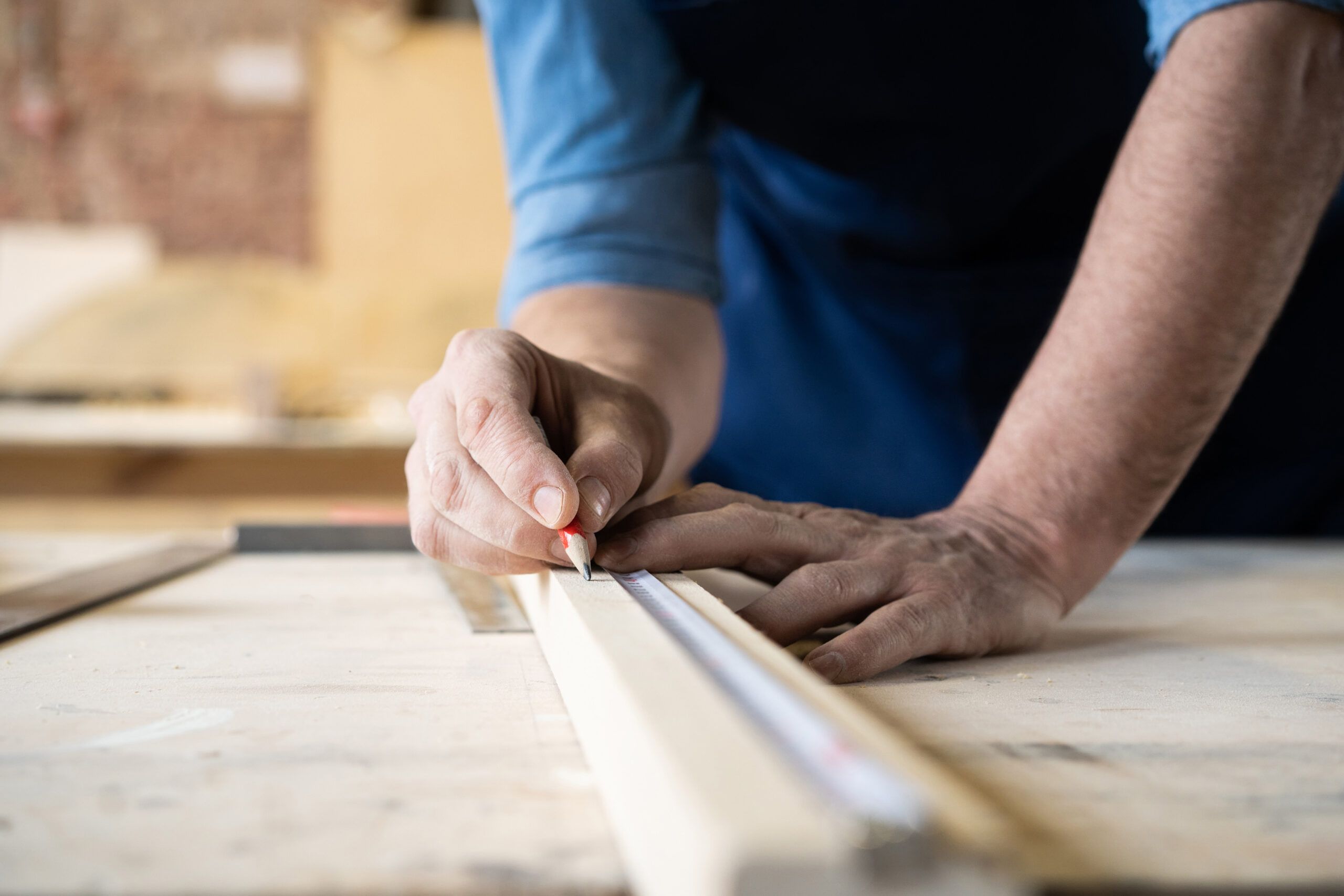
When cutting small trim on a miter saw, it’s helpful to add a thin board across the entire length of the saw fence to back up your cuts. You can either hold it in place by clamping it to both sides of the saw fence or by screwing it to the fence from behind (most miter saw fences have small holes for this purpose).
For safety’s sake, always keep your fingers away from the miter saw blade. If you need to cut very short pieces of trim, clamp them to the fence or hold them down with a long piece of scrap wood.
When fitting miter cuts for inside and outside corners, you can use an angle finder or protractor, which gets placed into the corner and measures the actual angle to see if it’s more or less than 90 degrees. Divide the measured angle in half to get the degrees to cut each half of the miter cut.
Get Started on Your Installation
To keep things organized, it’s a good idea to rough-cut all your pieces a few inches longer than you’ll need them to be and then position each piece on the floor where you plan to install each one. This will help you avoid cutting the wrong pieces when walking back and forth to the saw to make cuts. It will also let you know if you have enough material to finish the job before you start installing.
Cut and fit the appropriate joints on both ends of each piece before nailing it to the baseboard trim with the brad nailer. Then move on to the next piece, gluing miter joints and nailing more pieces to the baseboard until you’ve worked your way around the room. For more details, follow the instructions below.
How to cut inside corners
Inside corners are a good place to start fitting and installing the shoe molding. If either of the pieces of molding will terminate in another inside corner at the other end, measure the distance on the baseboard between the two inside corners and cut the piece to that length.
Tip: When cutting between two inside corners, you can cut shoe molding 1/16 to 1/8 of an inch longer than the length of the baseboard to start because the thin molding is flexible enough to bend into place. This will give you some wiggle room for recutting the miter if the angle is slightly off after your initial cut. It will also ensure that the shoe molding fits nice and tight into both corners.
If the other end does not end at an inside corner, leave it a couple of inches long to ensure you have enough length to cut the next joint.
Start by using the angle finder to measure the inside corner of the baseboard. Then make opposing 45-degree cuts (or slightly bigger or smaller angles if your angle finder says the corner is more or less than 90 degrees) on two adjacent pieces that will meet at the inside corner and place them into the corner to see how they fit. If the miter is open at the outer edge, carefully cut each of the angles a little shallower, and if the miter is open at the back, cut each angle a little steeper to get a tight fit.
Once the miter fits well, hold the pieces into place and carefully mark each piece where it will get cut at the other end. If the other end is an inside corner, you just repeat the above steps. If it’s an outside corner, scarf joint, or miter return, follow the appropriate steps below.
How to cut outside corners
Outside corners typically get cut after the other end of a piece of shoe molding has already been fitted, so if the other end of a piece terminates in an inside corner, a scarf joint, or a miter return, fit that first and continue with the outside corner afterwards. Then, holding the piece tight into the previously fitted joint, make a mark on the back edge of the shoe molding just past the end of the outside corner of the baseboard. While still holding the piece in place, make a tick mark at an angle away from the length mark as a reminder of which direction to make the cut when you take it to the saw.
Next, use your angle finder to measure the outside corner of the baseboard you are wrapping the shoe molding around. Divide the angle in half to get the degrees of each of the miter cuts you need to make. Then, carefully align the miter saw blade with the length mark you made on the back edge of one of the pieces and make the miter cut. Do the same for the miter cut on the other piece.
Tip: When cutting a miter on your miter saw, make your first cut a bit past the mark you made for your cut, and then carefully nudge the piece over, repeating the cutting process until the blade falls just past the line. This ensures that you don’t accidentally cut the piece too short. It’s also a good idea to cut outside miter angles a half degree more than the actual measurement because that will ensure that the outside corner of the joint closes up nice and tight.
How to cut scarf joints
If a wall is longer than the available pieces of shoe molding, you will need to join two pieces with a scarf joint. This is done by cutting the same angle on both pieces where they will overlap and fit tight to each other. Scarf joints are preferred to butt joints for joining pieces because a scarf joint will help align the two pieces and it will provide more surface area for gluing.
To make a scarf joint, first fit the joint at the other end of each of the two pieces, then lay them in position so they pass each other sitting on the floor. Then rest the end of your combination square against the baseboard in a place where the two pieces of shoe molding overlap and make a pencil mark across both of them.
Make a tick mark in the same direction on both pieces showing the direction you want to cut the angle. Then, on each piece, cut to the correct side of the mark you made with the combination square-you should be cutting on the side away from the other joint you already cut on each piece. It’s a good idea to cut each piece a little past the mark to start, and then test fit and recut if needed, to ensure that you don’t cut the pieces too short.
How to cut butt joints and miter returns
When a piece of shoe molding ends on a flat surface instead of continuing around a corner, there are a couple ways to terminate the piece, depending on the situation and the look you prefer.
If the surface the molding is ending at is perpendicular to the shoe molding, use a simple 90-degree cut to create a butt joint. The length of this piece will be the distance from the surface the molding is abutting to the farthest point of the joint at the other end of the piece. Use your tape measure to get that measurement.
If you are terminating the shoe molding without abutting another surface-such as when the baseboard is on the same plane as the trim of an adjacent doorway, and you don’t want the shoe molding to continue over the door casing-a miter return is the nicest way to do this. This is where a tiny piece of the shoe molding is cut to fit into a miter cut on the end of the piece you’re terminating, so that it looks like an outside miter that dives into the wall.
To cut a miter return, measure and mark the length of the shoe molding where you want it to end, and then cut back in from that mark at a 45-degree angle. The space left by this cut is where a small triangular filler piece will go.
To make this filler, first make a clean 90-degree cut on the same end of a scrap of shoe molding (i.e., if your miter return is on the right side of the molding you cut to go on the wall, make the 90-degree cut on the right end of the scrap piece).
Next, set your miter saw 45 degrees in the opposite direction from the cut you made on the main piece of shoe molding and cut a small triangular piece off the end of the scrap as wide as the molding is thick. You may need to make a few of these tiny pieces before you get the length just right so it nests seamlessly into the miter joint.
After test fitting, apply wood glue to the mating surfaces of the joint and use one or two of the Collins spring clamps to hold the miter return together until the glue sets. If you don’t have a set of spring clamps, blue painter’s tape does a good job of holding small joints like this together when gluing.
If a miter return sounds too complicated to make, you can simply make a 30- or 45-degree cut (similar to one half of an inside miter joint) at the end of the shoe molding where you want to terminate it, or you can even just sand a rounded edge on a square cut at the end of the molding to create a finished look.
Nail and glue shoe molding in place
Nail each piece of molding in place after both joints are fitted but before fitting the joint at the other end of the next piece. The exception to this rule is when you have multiple small pieces that go around several turns in a small space; then you may want to keep two or more pieces loose until they are all fitted so you can test fit them all at once, and recut if needed, to get the joints as tight as possible.
Make sure that nails always go into the baseboard or other vertical surface, not the floor. It’s a good idea that your brad nailer has a soft rubber tip on it to prevent it from denting the molding as you nail it. You may have to adjust the depth setting on your nailer to get the heads of the brad nails to sink to just below the surface of the molding.
If any of them don’t sink all the way, you can use a hammer and nail set to drive them flush. Brad nails can typically be spaced 12 to 18 inches apart, but you may need to add nails closer together if there are dips in the wall or floor that you need to push the shoe molding tight against.
Add a liberal amount of wood glue to hold together every miter or scarf joint. Inside miters will hold themselves tight once the trim is nailed in place but use a spring clamp or painter’s tape to hold outside corners while the glue sets. Be sure to drive a nail close to every joint after gluing so it sits tight to the baseboard.
Occasionally, uneven surfaces or bends in the baseboard may make it difficult or impossible for shoe molding to sit tight to the wall. If the trim will be painted, you can hide these irregularities later with caulk. But if it’s stain-grade trim, you should do your best to get it to follow the bends, possibly by adding more nails or by cutting small kerfs in the back of the shoe molding where it needs to make an extra tight bend.
Work your way around the room, gluing and nailing the shoe molding in place, until you’ve completed the installation. You may want to soften the edges on outside miters, miter returns, and scarf joints with a piece of 150-grit sandpaper to make them look nice and clean.
Prep and paint shoe molding
Because you did the first coat before installing the shoe molding, the final finishing should be a breeze.
First, you will want to fill the nail holes with a putty or filler compatible with your chosen finish and then wipe or sand the trim smooth.
Next, protect floors using painter’s tape and drop cloths, and carefully apply additional coats of your chosen finish with a narrow-angled brush, such as a window sash brush.
Once you clean up your job site, your shoe molding project is complete. Take a step back and appreciate the fruits of your labor.
What You Need
Materials
- Shoe molding
- 1-1/2 inch 18-gauge brad nails
- Wood glue
- Painter’s tape
- Paint or finish of choice
- Wood filler, putty, or caulk to fill nail holes and gaps
Tools
